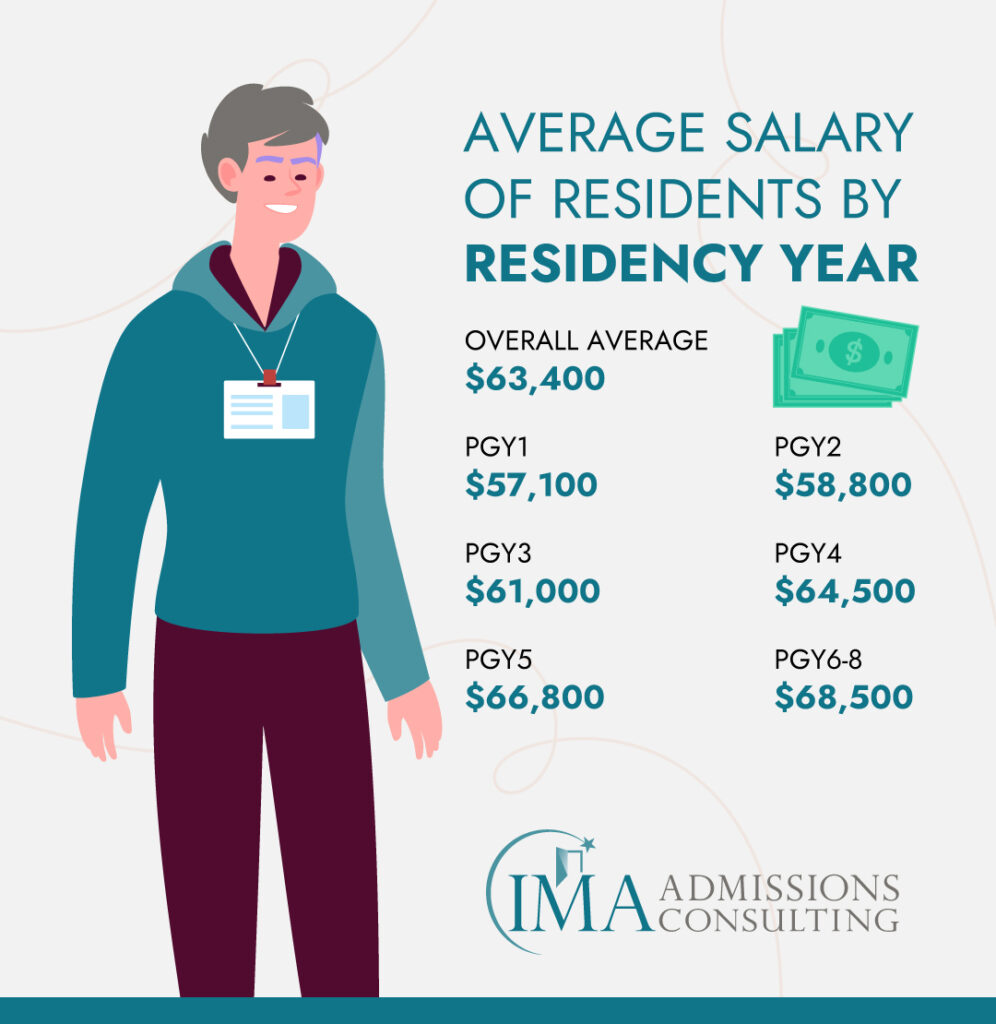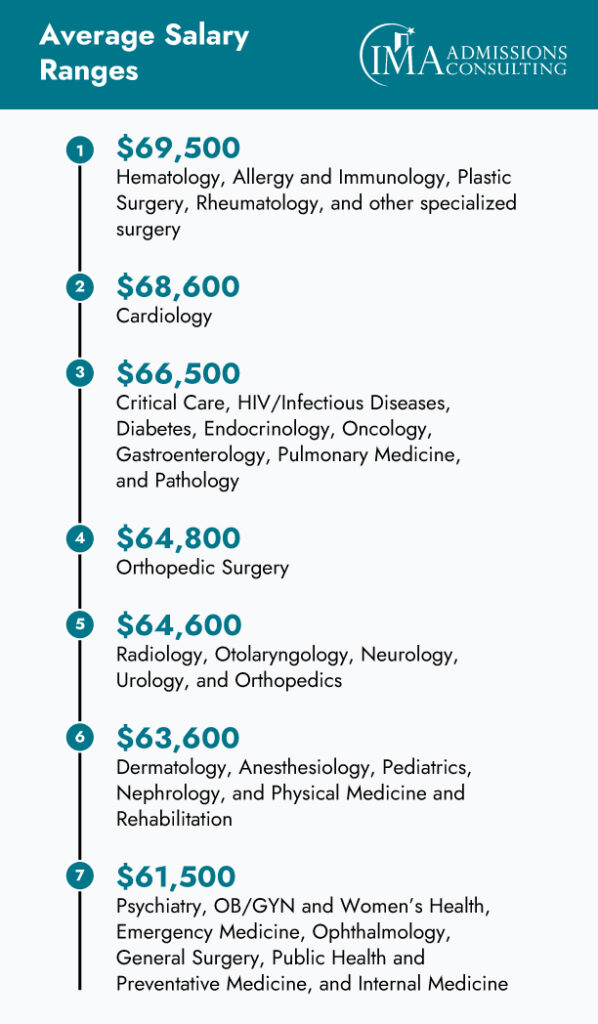Do You Get Paid During Residency?
Being accepted into a Graduate Medical Education (GME) program is an honored achievement in the careers of all young doctors. Now you get to focus most of your time and energy on gaining new, hands-on skills as a medical practitioner. However, your MD program, whether an MD or MD/PhD program, likely brought forth a sizeable amount of debt. Like many MD and DO students, you were unlikely to have maintained a part-time job while in medical school. After relying on student loans, scholarships, and institutional funding, the idea of having an income sounds very alluring. As you are filling out your ERAS application, you may be asking yourself, do you get paid during residency?
The short answer is yes. Think of a residency program in terms of other forms of graduate school education. Students in PhD programs almost never get admitted without some form of funding. High-level education like a PhD or medical residency is elite as statistically few people pursue this work and med/PhD students contribute to the institution training them. Medical residents teach, staff clinics, and perform rotations. Residents are no longer students in many senses, rather they are more like physicians in training. As trainee physicians, they are paid for the service they provide to the institution and those around them.
Unlike other occupations and paid graduate positions, the pay structure for residents isn’t negotiated on a person-by-person basis nor does it vary much based on one’s chosen medical specialty. How much residents make is largely decided by two factors—seniority and institution. To better understand how these two factors affect the salary of medical residents, let’s look further into the details of residency pay structures.
Residency Pay Structure
It’s important to note that different countries have varying residency pay structures. For example, the United States and Canada. In the US, resident pay varies by institution, but in Canada, the pay varies depending on which province you are working in.
Without going too in-depth, it should be noted that the pay difference lies within the type of healthcare system each country utilizes. The United States utilizes a private, for-profit healthcare system, meaning most cost aspects are determined by the hospital. Whereas Canada utilizes a network of provincially-administered systems similar to a single-payer structure. It makes sense that a country whose healthcare system is organized by governmental power has a more regulated and top-down pay structure. This is also one of the reasons why physicians in the US are among the highest-paid doctors in the world.
Now, let’s direct our attention away from the politics of healthcare systems and look at the nitty-gritty of residency pay.

How Much Do Residents Make in the United States
In the US, there are two primary sources for resident pay information. The first source is AMA’s FREIDA database, which provides information about first-year compensation stats across a wide variety of specialties. However, it needs to be noted that the FREIDA database also includes data from fellowships in their overall list, so the information can be deceiving. For reference, FREIDA lists the average first-year resident physician salary in abdominal radiology at $72,038.27 which is quite high for someone who is in their first-year post-graduate (PGY1). Abdominal radiology is trained in some subspecialty fellowships after one’s initial residency in radiology, so this number is reflective of a PGY4 or PGY5 wage.
The other source of residency compensation information is Medscape’s yearly Residents Salary and Debt Report. This report includes a further breakdown of contextual information, such as years beyond PGY1, medical school debt, and gender. Medscape’s sample size for this report is much smaller than that of FREIDA, but their most recent survey included 1600 respondents in 30 specialties. Like FREIDA, some of Medscape’s wage calculations include data from fellowships, so when you are looking at the higher end of averages, it is important to remember they are pay rates for those freshly out of med school.
Medscape’s surveys also include data on residents’ satisfaction with their pay and the number of hours/shifts worked. To get a more detailed picture of your would-be residency, we highly recommend reading each section of the Medscape survey. For those who may need assistance selecting a residency program or applying, we suggest Medical Residency Admissions and ERAS consulting.
Average Residency Pay in the US
There’s little variation in PGY1 pay for most residencies in the US, with the pay ranging from $57,000 to $62,000. The data for overall averages is inclusive of a wide range of programs and years, so it’s important to understand the compensation for family medicine which is short and ranks quite low on the list is calculated only from PGY1-3 numbers. Hematology, in contrast, is an average of PGY4-5, so the average compensation is higher.
With this in mind, let’s look at the average resident physician salary ranges for each specialty per Medscape’s numbers.

The following list is the average salary based on residency year:
Overall average – $63,400
- PGY1 – $57,100
- PGY2 – $58,800
- PGY3 – $61,000
- PGY4 – $64,500
- PGY5 – $66,800
- PGY6-8 – $68,500
There are a few points that can be made based on the information above. The first point is to note the hierarchical system. Residency programs that are available to recent DO and MD graduates don’t appear on the list until the $64,600 category with the exception of Pathology. Overall averages like this must be followed by identifying both the type of program and whether it is a true PGY1 program, combined program, or fellowship. For the most part, the former category (PGY1) begins at the $64,600 mark, and the latter (combined and fellowship) is the top 4 categories.
The next point is early match programs, such as neurology, ophthalmology, neurosurgery, and urology have higher averages than normal match residencies. While there are a few reasons for this, the primary reason is that these early match specialties are quite long. For example, Neurosurgery is one of the longest residencies, ranging from 6 to 10 years in some cases. Therefore the compensation average for that program includes PGY6-8 and beyond, which will be higher than the average compensation of a family medicine 3-year data set.
US Resident Pay - Other Aspects
Medscape’s survey provides other relevant information for MD and DO students prepping for their residency interviews.
Medscape notes that the pay gap between male and female residents is smaller than the pay gap between male and female practicing physicians. The former being approximately $700 difference, and the latter a nearly 25% difference in pay. While a $700 difference is still beyond the margin of error, it is more egalitarian than the post-residency landscape.
Resident satisfaction with pay is highest among PGY1 residents, with Medscape noting that 49% are satisfied with their compensation. This stat drops for PGY2 and 3 with their satisfaction at 37% and 43%. It’s hard to pull insight from this but is still interesting to consider, especially when thinking about how many students feel relieved to begin earning an income after completing med school. The first of earning a wage, no longer furthering one’s debt, and training in a specialty you are passionate about may be the happiest you’ll feel for a while. This happiness may decrease as you progress through residency and the schedule becomes more demanding.
In the US, the majority of residents will receive added benefits like dental insurance, health insurance, and paid time off. Due to the nature of the United States healthcare system and medical unions, these benefits vary widely from institution to institution.
It is also worth mentioning that there are opportunities for non-salary compensation within US residency programs. This includes moonlighting, on-call assistant shifts, and hospital coverage shifts. While these one-off opportunities won’t make much difference to your overall earnings, they can help offset surprise expenses.
Conclusion
While pay is an important factor in medical residency, there are some non-monetary Medscape stats we’d like to highlight. Of the 1600 residents surveyed, 77% reported being satisfied with their learning experience and 88% said they have good relationships with their attending physician. 82% of residents also reported having a good relationship with the nurses and PAs they work alongside. Overall, residents are happy with their programs and while compensation varies, the learning structure continues to be enlightening.
You will have plenty of time to pay off your medical school debt after finishing your residency. During your residency, you should try to enjoy the training and learning experience rather than focusing on earning the highest wage possible to pay off student loans. Plus, your earnings as a practicing physician will likely be 4 to 5 times that of your residency.
We wish you the best of luck as you venture to the next stage of your medical education, and for those who may need guidance when it comes to applying for residency, we are always here to offer our Medical Residency Admissions and ERAS consulting.
Frequently Asked Questions
What US residencies are the highest paid?
At the top of the list are allergy and immunology, medical geneticists, hematology, rheumatology, and most forms of specialized surgery. It is important to remember that these are subspecialty residencies (PGY4+).
What are the highest paid doctors?
Doctors who practice specialized surgery disciplines are always among the highest paid. Recent numbers single out orthopedic and plastic surgeons as the highest earners, earning $511k and $479k, respectively.
Is there a link between residency competitiveness and pay?
Yes, to some extent. These variations in pay aren’t overly large in the grand scheme of things. Of course, there are also exceptions to this like dermatology. Dermatology is an extremely competitive residency but sits right around the average mark for resident pay. It is important to consider when during the medical career these residencies take place, as subspecialty residencies (PGY4+) will always have higher average pay than residencies for PGY1 and PGY2.
Are there non-salary compensation opportunities?
Yes. While these vary by institution, there are often moonlighting, on-call assistant shifts, and hospital coverage shift opportunities. All of these provide non-salary compensation.
Why do family medicine residents get paid less?
When researching “how much do resident doctors make” many will see that family medicine is ranked among the lowest in earnings. While the average income for a family medicine resident is less than other residencies, they aren’t being paid less. A family medicine residency is much shorter than other medical specialty residencies, meaning the data for the average salary is only inclusive of up to PGY3-4.
If I switch residencies will I go back to a PGY1 salary?
In the US, if you switch from one residency to another (assuming both are normal match), you are likely to experience a slight pay cut. The big exception is when moving from a general residency to a more specialized one, in this case, you will be reset to earning a PGY1 wage.
How much more do fellows earn than residents?
When thinking about fellowships, it is best not to think of them as standalone programs, but rather as residencies that begin at PGY4 and beyond. The pay for a fellowship is at least that of what a PGY4 and onward would earn in residency.







